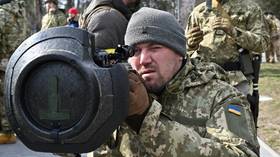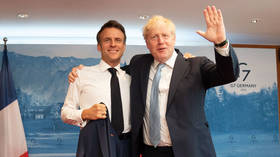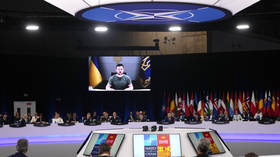
Photograph Source: Mirek Pruchnicki from Przemyśl, Sanok, Polska – Ukrainian children are fleeing Russian aggression. Przemyśl, Poland 27/02/2022 – CC BY 2.0
When Russia invaded Ukraine on February 24th, I was easing my way into a new job and in the throes of the teaching year. But that war quickly hijacked my life. I spend most of my day poring over multiple newspapers, magazines, blogs, and the Twitter feeds of various military mavens, a few of whom have been catapulted by the war from obscurity to a modicum of fame. Then there are all those websites to check out, their color-coded maps and daily summaries catching that conflict’s rapid twists and turns.
Don’t think I’m writing this as a lament, however. I’m lucky. I have a good, safe life and follow events there from the comfort of my New York apartment. For Ukrainians, the war is anything but a topic of study. It’s a daily, deadly presence. The lives of millions of people who live in or fled the war zone have been shattered. As all of us know too well, many of that country’s cities have been badly damaged or lie in ruins, including people’s homes and apartment buildings, the hospitals they once relied on when ill, the schools they sent their children to, and the stores where they bought food and other basic necessities. Even churches have been hit. In addition, nearly 13 million Ukrainians (including nearly two-thirds of all its children) are either displaced in their own country or refugees in various parts of Europe, mainly Poland. Millions of lives, in other words, have been turned inside out, while a return to anything resembling normalcy now seems beyond reach.
No one knows how many non-combatants have been slaughtered by bullets, bombs, missiles, or artillery. And all this has been made so much worse by the war crimes the Russians have committed. How does a traumatized society like Ukraine ever become whole again? And in such a disastrous situation, what could the future possibly hold? Who knows?
To break my daily routine of following that ongoing nightmare from such a distance, I decided to look beyond the moment and try to imagine how it might indeed end.
Current Battlelines
It’s easy to forget just how daring (or rash) Russian President Vladimir Putin’s decision to invade Ukraine was. After all, Russia aside, Ukraine is Europe’s biggest country in land area and its sixth-largest in population. True, Putin had acted aggressively before, but on a far more modest and careful scale, annexing Crimea and fostering the rise of two breakaway enclaves in parts of Donbas, the eastern Ukrainian provinces of Lugansk and Donetsk, which are industrial and resource-rich areas adjoining Russia. Neither was his 2015 intervention in Syria to save the government of Bashar al-Assad a wild-eyed gamble. He deployed no ground troops there, relying solely on airstrikes and missile attacks to avoid an Afghanistan-style quagmire.
Ukraine, though, was a genuinely rash act. Russia began the war with what seemed to be a massive advantage by any imaginable measure — from gross domestic product (GDP) to numbers of warplanes, tanks, artillery, warships, and missiles. Little wonder, perhaps, that Putin assumed his troops would take the Ukrainian capital, Kyiv, within weeks, at most. And he wasn’t alone. Western military experts were convinced that his army would make quick work of its Ukrainian counterpart, even if the latter’s military had, since 2015, been trained and armed by the United States, Britain, and Canada.
Yet the campaign to conquer key cities — Kyiv, Chernihiv, Sumy, and Kharkiv — failed disastrously. The morale of the Ukrainians remained high and their military tactics adept. By the end of March, Russia had lost tanks and aircraft worth an estimated $5 billion, not to speak of up to a quarter of the troops it had sent into battle. Its military supply system proved shockingly inept, whether for repairing equipment or delivering food, water, and medical supplies to the front.
Subsequently, however, Russian forces have made significant gains in the south and southeast, occupying part of the Black Sea coast, Kherson province (which lies north of Crimea), most of Donbas in the east, and Zaporozhizhia province in the southeast. They have also created a patchy land corridor connecting Crimea to Russia for the first time since that area was taken in 2014.
Still, the botched northern campaign and the serial failures of a military that had been infused with vast sums of money and supposedly subjected to widespread modernization and reform was stunning. In the United States, the intrepid Ukrainian resistance and its battlefield successes soon produced a distinctly upbeat narrative of that country as the righteous David defending the rules and norms of the international order against Putin’s Russian Goliath.
In May, however, things began to change. The Russians were by then focused on taking the Donbas region. And bit by bit, Russia’s advantages — shorter supply lines, terrain better suited to armored warfare, and an overwhelming advantage in armaments, especially artillery — started paying off. Most ominously, its troops began encircling a large portion of Ukraine’s battle-tested, best-trained forces in Donbas where besieged towns like Sievierodonetsk, Lysychansk, Lyman, and Popasna suddenly hit the headlines.
Now, at the edge of… well, who knows what, here are three possible scenarios for the ending of this ever more devastating war.
1. De Facto Partition
If — and, of course, I have to stress the conditional here, given repeatedly unforeseen developments in this war — Putin’s army takes the entire Donbas region plus the whole Black Sea coast, rendering Ukraine smaller and landlocked, he might declare his “special military operation” a success, proclaim a ceasefire, order his commanders to fortify and defend the new areas they occupy, and saddle the Ukrainians with the challenge of expelling the Russian troops or settling for a de facto partition of the country.
Putin could respond to any Ukrainian efforts to claw back lost lands with air and missile strikes. These would only exacerbate the colossal economic hit Ukraine has already taken, including not just damaged or destroyed infrastructure and industries, a monthly budget shortfall of $5 billion, and an anticipated 45% decline in GDP this year, but billions of dollars in revenue lost because it can’t ship its main exports via the Russian-dominated Black Sea. An April estimate of the cost of rebuilding Ukraine ranged from $500 billion to $1 trillion, far beyond Kyiv’s means.
Assuming, on the other hand, that Ukraine accepted a partition, it would forfeit substantial territory and President Volodymyr Zelensky could face a staggering backlash at home. Still, he may have little choice as his country could find the economic and military strain of endless fighting unbearable.
Ukraine’s Western backers may become war weary, too. They’ve just begun to feel the economic blowback from the war and the sanctions imposed on Russia, pain that will only increase. While those sanctions have indeed hurt Russia, they’ve also contributed to skyrocketing energy and food prices in the West (even as Putin profits by selling his oil, gas, and coal at higher prices). The U.S. inflation rate, at 8.6% last month, is the highest in 40 years, while the Congressional Budget Office has revised estimates of economic growth — 3.1% this year — down to 2.2% for 2023 and 1.5% for 2024. All this as mid-term elections loom and President Biden’s approval ratings, now at 39.7%, continue to sink.
Europe is also in economic trouble. Inflation in the Eurozone was 8.1% in May, the highest since 1997, and energy prices exploded. Within days of the Russian invasion, European natural gas prices had jumped nearly 70%, while oil hit $105 a barrel, an eight-year high. And the crunch only continues. Inflation in Britain, at 8.2%, is the worst since 1982. On June 8th, gasoline prices there reached a 17-year high. The Organization of Economic Cooperation and Development anticipates that the French, German, and Italian economies (the three largest in Europe) will contract for the rest of this year, with only France’s registering an anemic 0.2% growth in the fourth quarter. No one can know for sure whether Europe and the U.S. are headed for a recession, but many economists and business leaders consider it likely.
Such economic headwinds, along with the diminution of the early euphoria created by Ukraine’s impressive battlefield successes, could produce “Ukraine fatigue” in the West. The war has already lost prominence in news headlines. Meanwhile, Ukraine’s biggest supporters, including the Biden administration, could soon find themselves preoccupied with economic and political challenges at home and ever less eager to keep billions of dollars in economic aid and weaponry flowing.
The combination of Ukraine fatigue and Russian military successes, however painfully and brutally gained, may be precisely what Vladimir Putin is betting on. The Western coalition of more than three dozen states is certainly formidable, but he’s savvy enough to know that Russia’s battlefield advantages could make it ever harder for the U.S. and its allies to maintain their unity. The possibility of negotiations with Putin has been raised in France, Italy, and Germany. Ukraine won’t be cut off economically or militarily by the West, but it could find Western support ever harder to count on as time passes, despite verbal assurances of solidarity.
All of this could, in turn, set the stage for a de facto partition scenario.
2. Neutrality with Sweeteners
Before the war, Putin pushed for a neutral Ukraine that would foreswear all military alliances. No dice, said both Ukraine and NATO. That alliance’s decision, at its 2008 Bucharest summit, to open the door to that country (and Georgia) was irrevocable. A month after the Russian invasion began, Zelensky put neutrality on the table, but it was too late. Putin had already opted to achieve his aims on the battlefield and was confident he could.
Still, Russia and Ukraine have now been fighting for more than three months. Both have suffered heavy losses and each knows that the war could drag on for years at a staggering cost without either achieving its aims. The Russian president does control additional chunks of Ukrainian territory, but he may hope to find some way of easing Western sanctions and also avoiding being wholly dependent on China.
These circumstances might revive the neutrality option. Russia would retain its land corridor to Crimea, even if with some concessions to Ukraine. It would receive a guarantee that the water canals flowing southward to that peninsula from the city of Kherson, which would revert to Ukrainian control, would never again be blocked. Russia would not annex the “republics” it created in the Donbas in 2014 and would withdraw from some of the additional land it’s seized there. Ukraine would be free to receive arms and military training from any country, but foreign troops and bases would be banned from its territory.
Such a settlement would require significant Ukrainian sacrifices, which is why candidate membership in the European Union (EU) and, more importantly, a fast track to full membership — one of that country’s key aspirations — as well as substantial long-term Western aid for economic reconstruction would be a necessary part of any deal. Expediting its membership would be a heavy lift for the EU and such an aid package would be costly to the Europeans and Americans, so they’d have to decide how much they were willing to offer to end Europe’s biggest conflict since World War II.
3. A New Russia
Ever since the war began, commentators and Western leaders, including President Biden, have intimated that it should produce, if not “regime change” in Russia, then Putin’s departure. And there have been no shortage of predictions that the invasion will indeed prove Putin’s death knell. There’s no evidence, however, that the war has turned his country’s political and military elite against him or any sign of mass disaffection that could threaten the state.
Still, assume for a moment that Putin does depart, voluntarily or otherwise. One possibility is that he would be replaced by someone from his inner circle who then would make big concessions to end the war, perhaps even a return to the pre-invasion status quo with tweaks. But why would he (and it will certainly be a male) do that if Russia controls large swathes of Ukrainian land? A new Russian leader might eventually cut a deal, providing sanctions are lifted, but assuming that Putin’s exit would be a magic bullet is unrealistic.
Another possibility: Russia unexpectedly becomes a democracy following prolonged public demonstrations. We’d better hope that happens without turmoil and bloodshed because it has nearly 6,000 nuclear warheads, shares land borders with 14 states, and maritime borders with three more. It is also the world’s largest country, with more than 17 million square kilometers (44% larger than runner-up Canada).
So, if you’re betting on a democratic Russia anytime soon, you’d better hope that the transformation happens peacefully. Upheaval in a vast nuclear-armed country would be a disaster. Even if the passage to democracy isn’t chaotic and violent, such a government’s first order of business wouldn’t be to evacuate all occupied territories. Yet it would be so much more likely than the present one to renounce its post-invasion territorial gains, though perhaps not Russian-majority Crimea, which, in the era of the Soviet Union, was part of the Russian republic until, in 1954, it was transferred to the Ukrainian republic by fiat.
This Needs to End
The suffering and destruction in Ukraine and the economic turmoil the war has produced in the West should be compelling enough reasons to end it. Ditto the devastation it continues to create in some of the world’s poorest countries like Kenya, Ethiopia, Somalia, and Yemen. Along with devastating droughts and local conflicts, it has led to staggering increases in the price of basic foods (with both Ukrainian and Russian grains, to one degree or another, blocked from the market). More than 27 million people are already facing acute food shortages or outright starvation in those four nations alone, thanks at least in part to the conflict in Ukraine.
Yes, that war is Europe’s biggest in a generation, but it’s not Europe’s alone. The pain it’s producing extends to people in faraway lands already barely surviving and with no way to end it. And sadly enough, no one who matters seems to be thinking about them. The simple fact is that, in 2022, with so much headed in the wrong direction, a major war is the last thing this planet needs.
This column is distributed by TomDispatch





